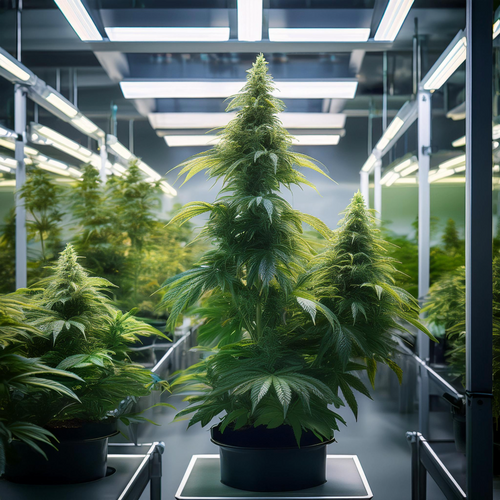
Growing cannabis is a fascinating and increasingly popular subject for both amateur gardeners and professional growers. In many parts of the world, growing cannabis is becoming increasingly legal, leading to wider acceptance and interest in the best cultivation methods. Whether you are an experienced grower or just starting out in cannabis cultivation, there are many techniques that can affect the quality and yield of your plants.
In this blog post, we'll take a look at different growing methods you can try to get the most out of your cannabis plants.
1. The classic outdoor cultivation
Outdoor cultivation is the most traditional method of growing cannabis. It involves cultivating the plant in a natural, open-air environment, which provides the plant with plenty of sunlight, natural air circulation and space to grow.
Advantages:
- Free lighting : Sunlight is free and ideal for growing cannabis.
- Large plants : Outdoor plants can grow very large, which can lead to higher yields.
- Ease of use : Compared to indoor techniques, outdoor cultivation requires less technical equipment.
Disadvantages:
- Weather dependence : The success of cultivation depends heavily on climatic conditions.
- Safety Risks : Outdoor cultivation may be visible to unauthorized persons, which can lead to theft or legal problems.
2. Indoor cultivation
Indoor cultivation allows complete control over environmental conditions. Cannabis is grown in an enclosed space under artificial lighting, temperature and humidity control, and ideal air circulation.
Advantages:
- Controlled environment : You can precisely control every variable, from temperature and light to humidity.
- Safer and more discreet : Indoor cultivation can be done in a private space, offering greater security and discretion.
- Year-round cultivation : You are not dependent on seasonal fluctuations.
Disadvantages:
- Cost : Setting up an indoor system can be expensive because it requires lighting, ventilation and other technical components.
- Space requirement : It requires sufficient space and good equipment to grow optimally.
3. Hydroponics
Hydroponics is a method of growing cannabis without soil, but in a nutrient solution. The roots of the plants grow directly in a water-nutrient mixture that is regularly enriched with the necessary minerals.
Advantages:
- Faster growth : Plants grown in a hydroponic system can thrive faster because they have direct access to nutrients.
- Fewer pests : Since no soil is used, there are fewer risks from pests that typically live in soil.
- Water and nutrient control : You have complete control over the nutrients and water, allowing for optimal nutrition.
Disadvantages:
- Complexity : Hydroponic systems require a certain level of technical knowledge and constant monitoring of nutrient solutions.
- Cost and Setup : The initial investment for hydroponic systems can be high.
4. Aeroponics
Aeroponics is an advanced form of hydroponic cultivation in which the roots of the plants are suspended in the air and regularly sprayed with a nutrient solution. This method therefore does not use solid soil or water containers, but allows for very efficient nutrient uptake.
Advantages:
- Less water consumption : Aeroponics requires far less water than other cultivation methods.
- Higher oxygen supply : Because the roots are suspended in the air, they have direct access to oxygen, which can accelerate growth.
- Fast growth : This method promotes rapid root growth and therefore faster plant growth.
Disadvantages:
- Technical requirements : Aeroponic systems are very complex and require careful monitoring and control.
- High initial costs : Setting up an aeroponic system is expensive and requires technical knowledge.
5. SOG (Sea of Green)
The SOG technique is a method of indoor cultivation that involves growing a large number of small cannabis plants in a compact space, rather than a few large plants. The goal is to harvest a large number of flowers as quickly as possible by preparing the plants for a short flowering period while they are still in the vegetative phase.
Advantages:
- Fast harvest : Since many plants bloom at the same time, you can harvest several crops in a short period of time.
- Compact space : This method uses the available space efficiently and allows for high plant density.
Disadvantages:
- Smaller plants : Each plant remains relatively small, reducing the yield per plant.
- Space for many plants : You need enough space to care for a large number of small plants.
6. SCROG (Screen of Green)
SCROG is a method where a net or trellis is placed over the plants to direct the growth of the shoots in a horizontal direction. This causes the plant to grow wider rather than taller, which can maximize yield.
Advantages:
- Maximizing light : Horizontal growth allows all leaves to reach light evenly, increasing yield.
- Growth Control : SCROG helps control plant growth and optimize structure.
Disadvantages:
- Space requirements : You need enough space to effectively implement a SCROG system.
- Time-consuming : This technique requires regular care and adjustment of the plant.
Conclusion: The best method depends on your goal
There is no "one method" for the perfect cannabis grow. Rather, it comes down to your own preferences, available space, budget and goals. Outdoor growing is ideal for those who want natural growth, while indoor growing offers the control and flexibility to create optimal conditions. Techniques such as hydroponics and aeroponics offer faster growth and higher yields, but are more complex and expensive.
It's best to try different methods to find out which one works best for you and your growing conditions. And remember: patience and careful care are often the key to a successful cannabis grow.
